On the sign:
ΟΙ ΒΥΖΑΝΤΙΝΕΣ ΟΧΥΡΩΣΕΙΣ ΤΩΝ ΧΑΝΙΩΝ
THE BYZANTINE WALL OF CHANIA
[Map of the wall]
Οι βυζαντινές οχυρσεις των Χανίων, μήκους περίπου ενός χιλιομέτρου , αποτελούν το όριο που διαχωρίζει την παλιά πόλη από την οχυρωμένη της ακρόπολη , Στους παλιούς χάρτες της πόλης, αλλά και στον σύγχρονο πολεοδομικό ιστό, διακρίνεται καθαρά το περίγραμμα του Τείχους που περιέβαλε το λόφο Καστέλλι.
Τη σημερινή του μορφή την πήρε κατά τον 7ο αινα , στην πρτη βυζαντινή περίοδο , εν δέχτηκε εκτεταμένες επεμβάσεις κατά την περίοδο της Ενετοκρατίας . Με την οικοδόμηση των νέων εξωτερικν ενετικν οχυρσεων περιήλθε σε αχρηστία και με τα χρόνια ενσωματθηκε στις κατοικίες που αναπτύχθηκαν γύρω και πάνω από αυτό . Επίσης παρατηρούνται διανοίξεις χρων και στο. εσωτερικό της οχύρωσης οι οποίοι είχαν οικιστική χρήση αποθηκευτική και ορισμένοι λειτουργούσαν ως καταφύγια κατά τον 20 Παγκόσμιο Πόλεμο.
Οι πρτες μέχρι σήμερα ενδείξεις οχύρωσης περιμετρικά του λόφου ξεκινάνε από την ελληνιστική εποχή , καθως σε ένα σημείο στα νοτιοδυτικά είναι ορατή η αρχαία κρηπίδα κτισμένη εν ξηρω από κατεργασμένους λιθόπλινθους , Η βόρεια πλευρά της οχύρωσης αποτελεί συνέχεια των έντονων φυσικν βράχων , ενω οι υπόλοιπες πλευρές οικιστικά μινωικά κατάλοιπα. Σύμφωνα με πρόσφατα στοιχεία, στις οχυρσεις πραγματοποιήθηκαν σημαντικές επισκευές κατά τη ρωμαϊκή εποχή. Το Βυζαντινό Τείχος έχει κατασκευαστεί κυρίως με δομικό υλικό σε επανάχρηση (spolia) που προέρχεται από την αρχαία Κυδωνία και αποτελείται από ευθύγραμμα τμήματα (μεταπύργια) που εναλλάσσονται σε τακτά διαστήματα με μικρούς, ορθογνιους ή πολυγωνικούς πύργους .
Σήμερα, το μνημείο διατηρείται σε καλή κατάσταση και μετά από τις εργασίες συντήρησης και αποκατάστασης στο νότιο τμήμα του θα προχωρήσει η συνολική ανάδειξή του . Στην οδό Καραολή & Δημητρίου αποκαταστάθηκε . ο πύργος β , συμπληρωθηκαν οι τοξοθυρίδες του και αποκαλύφθηκε το προτείχισμα και μέρος της τάφρου του Τείχους . Στη συμβολή με την οδό Κατρέ υπήρχε η νότια είσοδος (Γ) της οχύρωσης , που ονομαζόταν και "σκαλάκια" , η οποία κατεδαφίστηκε μεταπολεμικά κατά τη διάνοιξη της οδού, Στην αρχή τη οδού Σήφακα στερεωθηκε ο πύργος γ και συντηρήθηκε η βόρεια είο οδός του στην οδό Τζαγκαρόλων.
[Images: Left to right, top to bottom
Ο λόφος του Καστελλιού από τον Ε. Nani, 1613
The Kastefli hill from E. Nani 1613
Η είσοδος του πύργου γ στην οδό Τζαγκαρόλων
Τhe entrance of tower y at Tzagkarolon st.
Ο πύργος α από τα νοτιοδυτικέ και η νότια πύλη Γ , G. Gerola, 1903
The tower α from southwest and the south gate r , G. Gerola, 1903
(2 Imagess)
Πρωτοβυζαντινό Τείχος Early 5ynine Wel Πρuιμη Ενετοκρατία Επισκευές Retonstrυεtiens Eitly Venti an perioα
Οι ιστορικές φάσεις στην οδό Καραολή & Δημητρίου
Τhe htstorical phases at Karaoli & Dimitriou st.]
The Byzantine wall of Chania, nearly one kilometer long, is the boundary which separates the old town from its fortified acropolis. The outline of the fortifications surrounding the Kastelli hill is clearly visible in the old maps of the town, as well as in the modern urban network.
The Byzantine wall took its current form in the 7th century during the first Byzantine period, but was subjected to extensive modifications during the Venetian occupation. With the building of the new external Venetian fortifications, the Byzantine wall fell into disuse and in time it was incorporated with the houses built around and on top of it. In addition, the openings observed at the interior of the fortifications had residential and storage use, while some functioned as shelters during World War II.
Up to date, the first indications of fortification along the perimeter of the hill are found in the Hellenistic period, as at a point to the south-west is visible the ancient wall base built in dry stone -method. The northern side of the wall continues the sharp natural rocks, while the other sides have been built upon soft limestone and remains of Minoan settlements. According to latest evidence, the fortifications underwent extensive repairs during the Roman period. The Byzantine wall has been constructed mainly with reused building material (spolia) derived from ancient Kydonia. It is constituted of linear parts interweaved at regular intervals with small rectangular or polygonal towers.
Today, the monument is preserved in very good condition and after the conservation and restoration works at the south side progress, the overall enhancement of the monument will be promoted. Along Karaoli & Dimitriou st., tower β has been restored and the tower’s arrow slits have been filled in. The lower protecting wall has been revealed, as well as part of the ditch. At the junction with Katre st., it used to be the south entrance (Γ) of the fortification which was demolished after World War II for opening of the street. At the beginning of Sifaka st., tower γ has been consolidated and its north entrance, located at Tzagkarolon st., was also conservated.
κείμενο // text: Ανδριανάκης Μιχάλης // Andrianakis Mihalis, Φαντάκης Γιάννης // Fantakis Giannis
σχεδιασμός // design: Βλαζάκη Ειρήνη // Vlazaki Eirini
μετάφραση // translation: Ατζολιδάκη Νίκη // Atzolidaki Niki
δημιουργία ενημερωτικής πιναικίδας στο πλαίσιο του έργου:
creation of the information panel within the project:
Συντήρηση και Απο κατάσταση του Βυζαντινού Τείχους Χανίων
Conserνation ond Rastoration of the Byzantine wall oί Chania
ΧΑΝΙΑ 2015 // CHANIA 2015
ΥΠΟΥΡΓΕΙΟ ΠΟΛΙΤΙΣΜΟΥ ΚΑΙ ΑΘΛΗΤΙΣΜΟΥ
MINISTRY OF COLTURE AND SPORTS
ΔΙΕΥΘΥΝΣΗ ΒΥΖΑΝΤΙΝΩΝ ΜΕΤΑΒΥΖΑΝΤΙΝΩΝ ΑΡΧΑΙΟΤΗΩΝ
DERECTORATE OF BYZANTINE & POST-BYZANTINE ANTIQUITIES
ΕΠΙΣΤΗΜΟΝΙΚΗ ΕΠΙΤΡΟΠΗ ΑΝΑΔΕΙΞΗΣ ΟΧΥΡΩΜΑΤΙΚΩΝ ΕΡΓΩΝ ΚΡΗΤΗΣ
SCIENTIFIC COMMITTEE FOR THE ENHANCEMENT OF FORTIFICATIONS OF CRETE

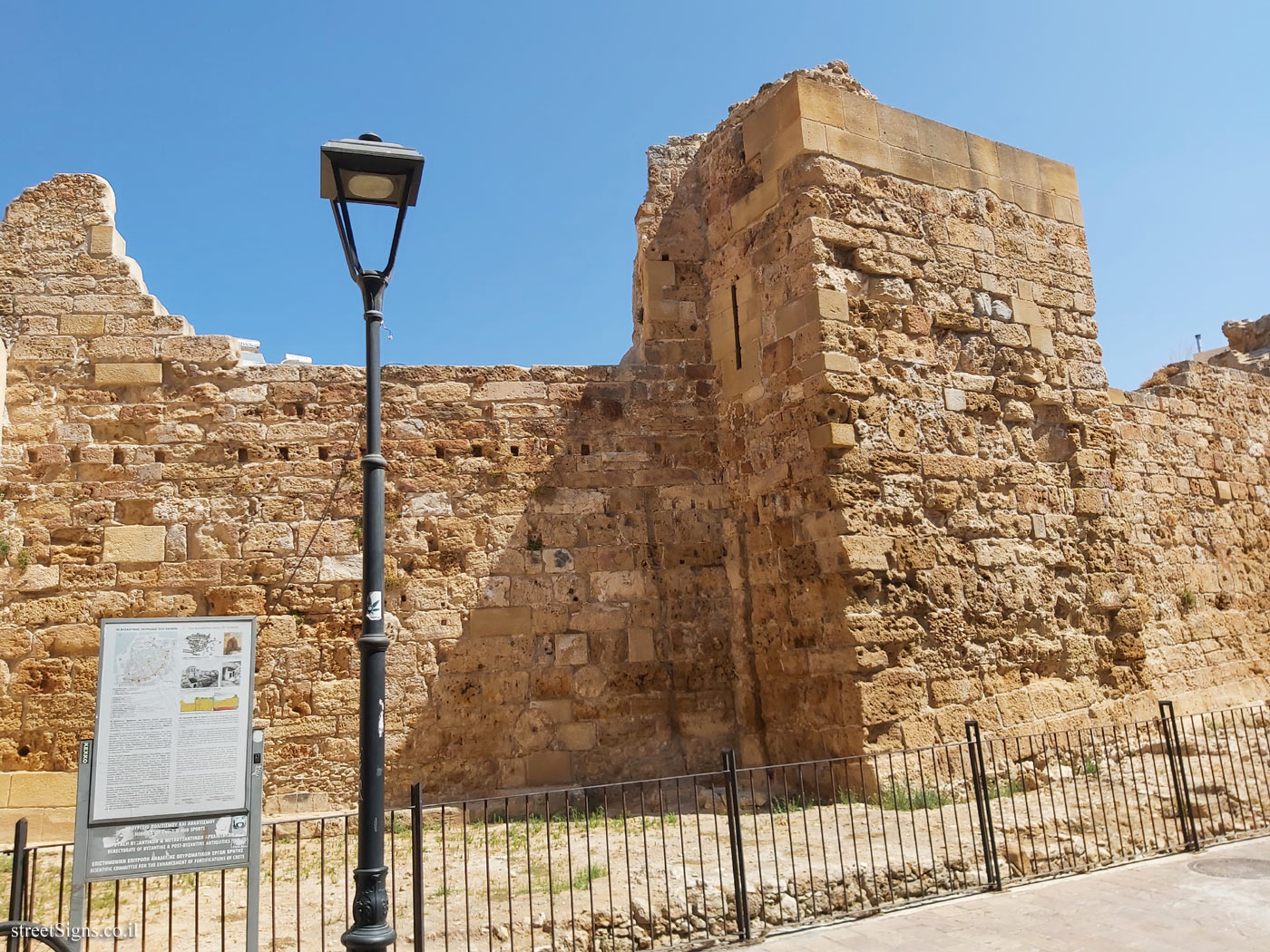 Click for a larger image
Click for a larger image 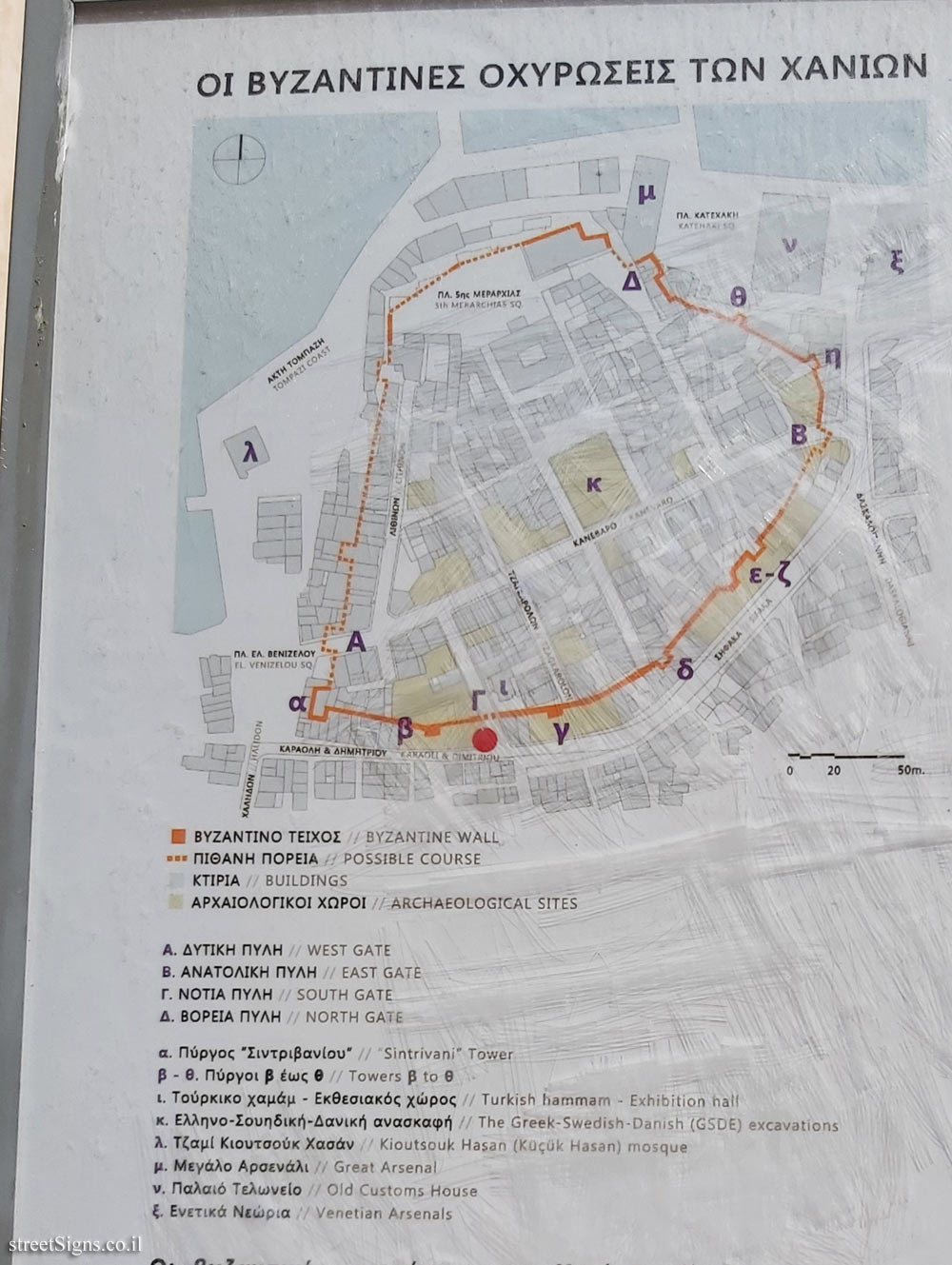 Click for a larger image
Click for a larger image 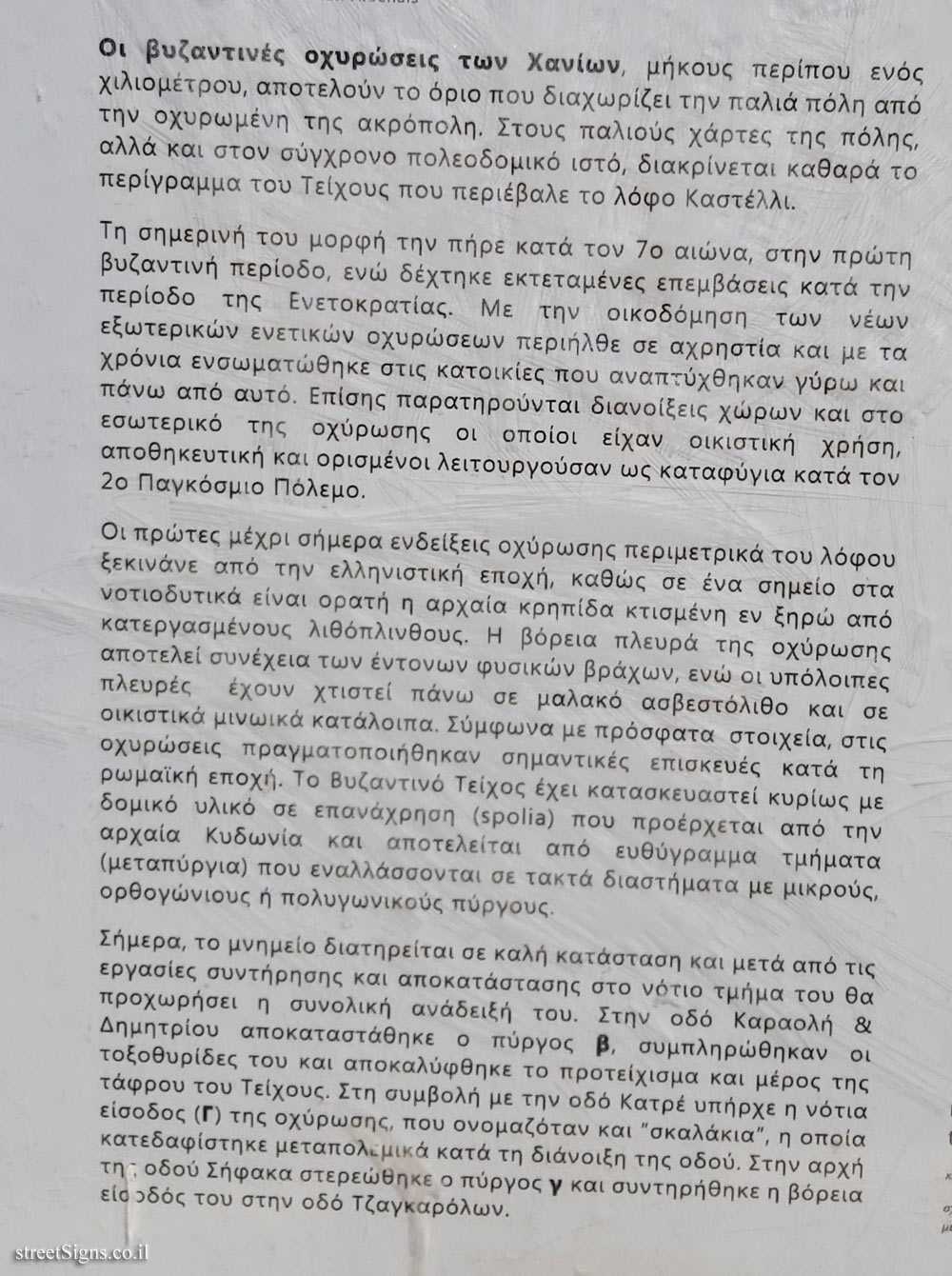 Click for a larger image
Click for a larger image 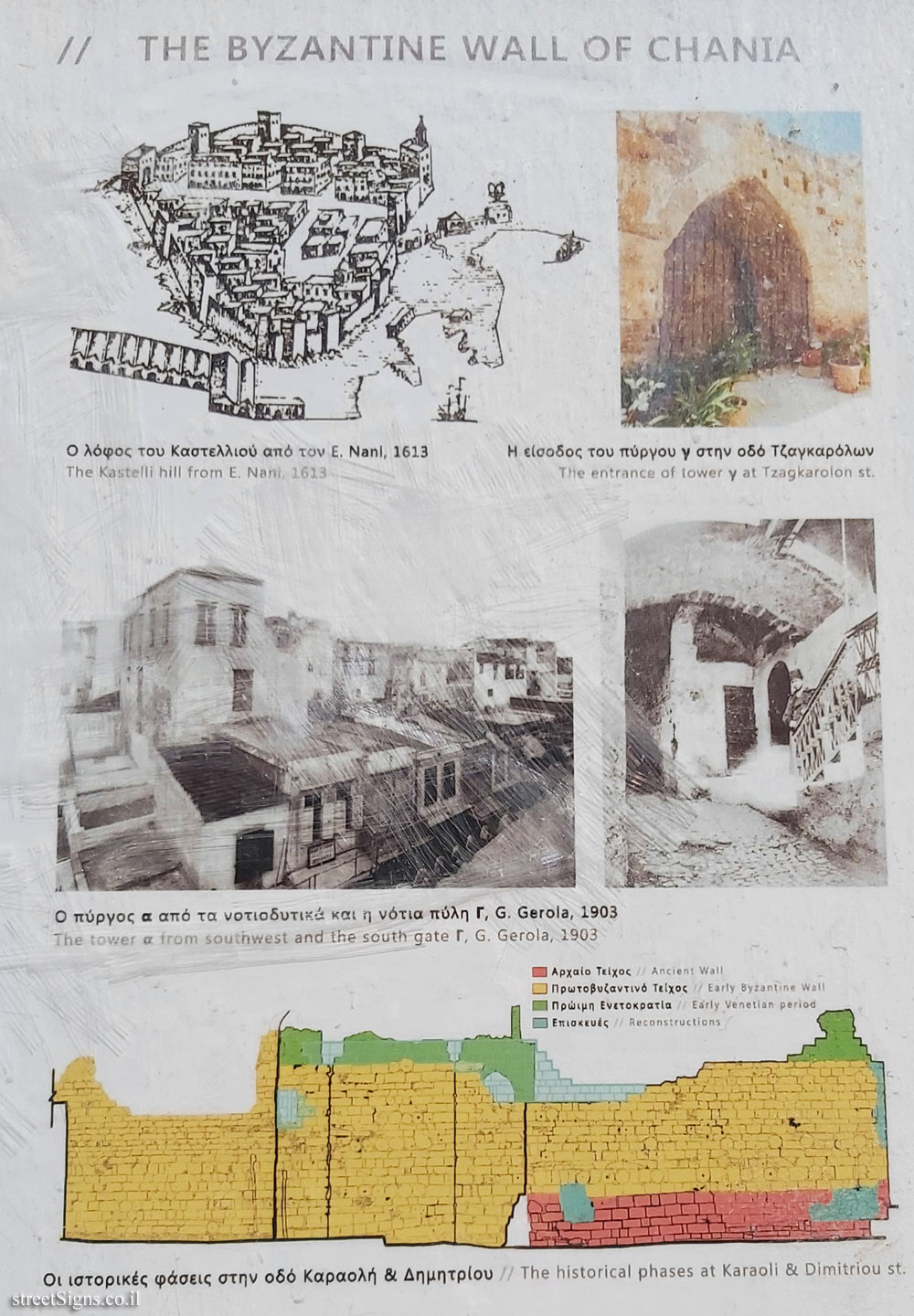 Click for a larger image
Click for a larger image 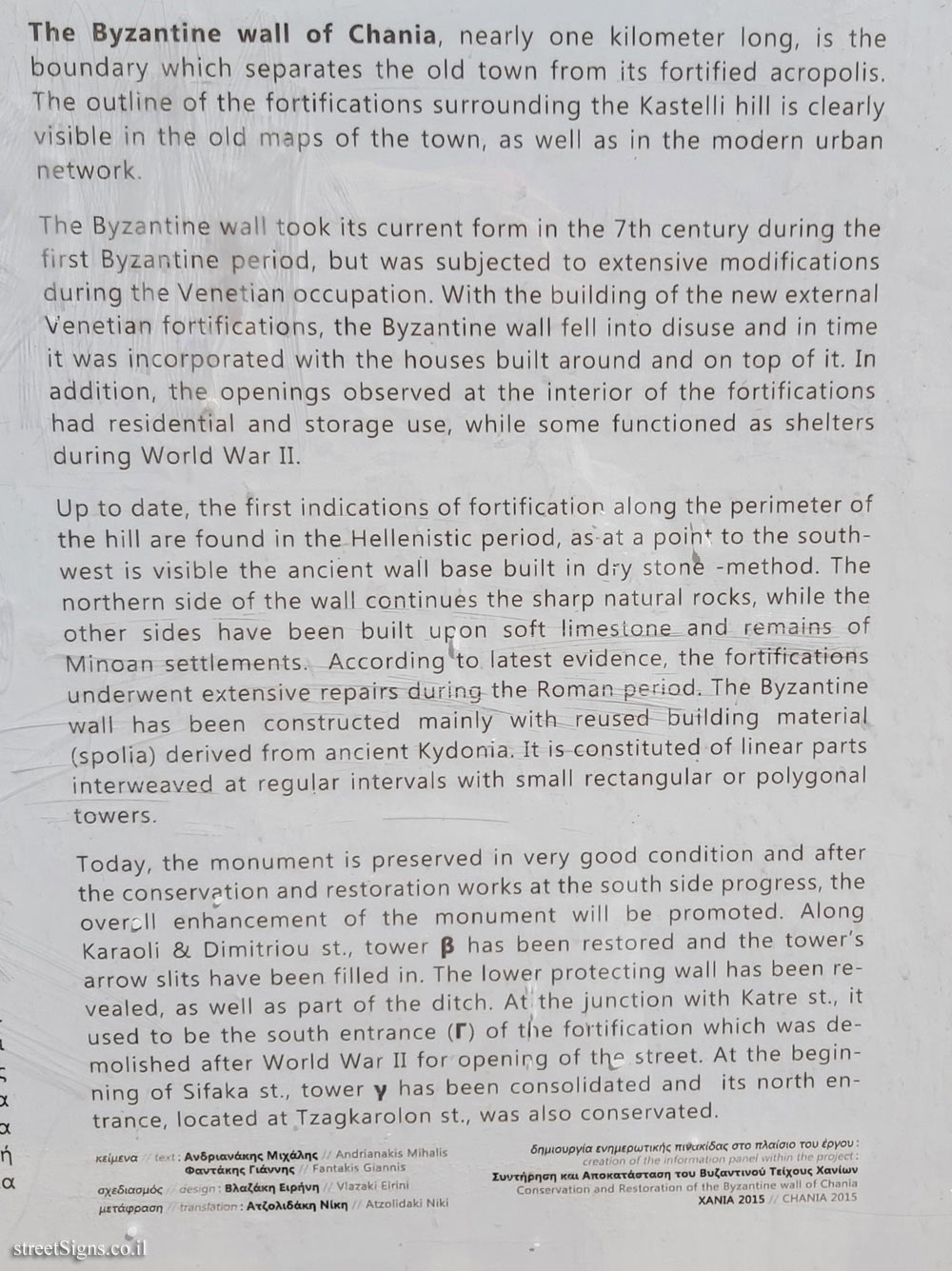 Click for a larger image
Click for a larger image